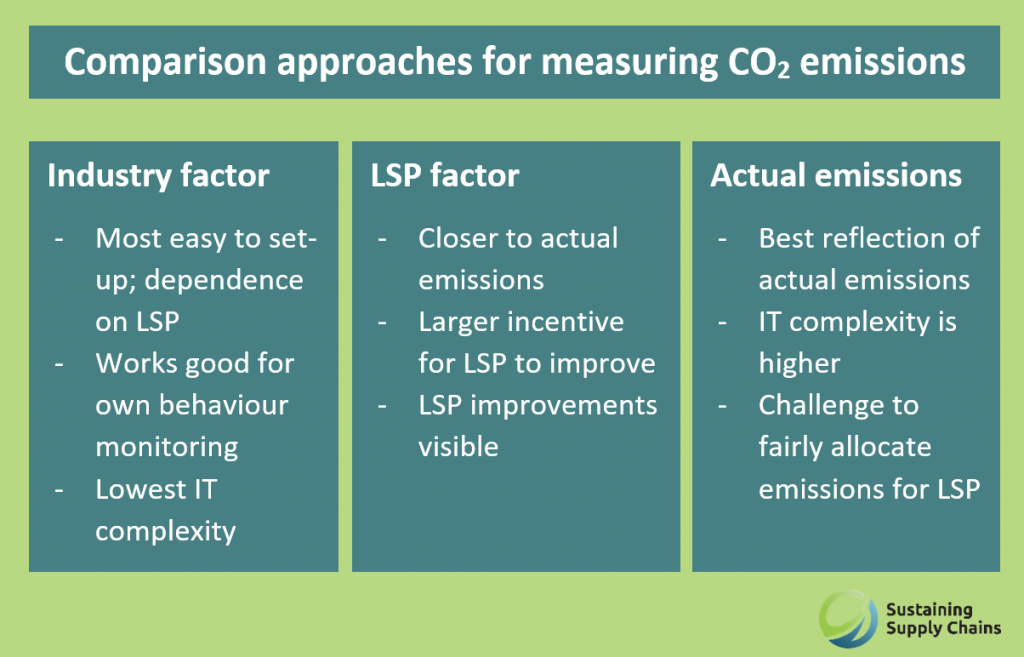Measuring CO2 emissions originating from transport of goods within Supply Chains can be done in different ways. The best option for your company depends on different factors. However, we believe everyone can and should start measuring its transport CO2 emissions. Measuring is key in knowing where you are currently and where to head for in the coming years. Sustainability and therewith CO2 emissions are becoming more and more important. Among many other reasons, also because of upcoming CO2 taxes within transport as discussed earlier here.
Depending on your role in the supply chain, you may face different challenges in measuring CO2 emissions. For shippers we see three phases in measuring. The first phase is measuring with industry standard emission factors, the second with a specific LSP factor and third based on actual emissions.
Industry standard emission factors
When no information from your LSP’s is available on emissions of your transports, the use of industry standard emission factors is very good way to calculate your transport emissions. The advantage is that you can start easily measuring as a company yourself and use this as a baseline to compare against. Next, you probably have the least technology challenges compared to the other options. Also, it is a good option to monitor effects of measures you take by changing your own behaviour. E.g. increase the MOQ leading to more (emission) efficient transports. Finally, you’re able to allocate emissions relatively easily on detailed level of e.g. shipment order line (which is handy for e.g. LCA-analyses).

LSP emission factor
If your LSP has insight in his CO2 emissions and his total tonkm [1] over a period, he can provide you with a specific emission factor for transports executed by this LSP. The big advantage of this approach is that you are closer to the actual emissions than by using industry averages. Besides, improvements that the LSP makes are better reflected. E.g. if your LSP trains his truck drivers, emissions can go down, which is hard to reflect by industry averages. Using LSP emission factors is relative easily incorporated when having an industry emission factor-based calculation in place. When using this approach, you have a good starter for a conversation with your LSP. Ideally you can reduce emissions by collaboration.
Combustion of 1 liter Diesel (B7 blend) causes 3.262 kg CO2e emission
Actual emissions
LSP’s can also deliver the actual emissions allocated to your shipments. This approach reflects the best the actual emissions in practice (ignoring the tank-to-wheel part, which should be considered). Since, there is a direct link into the fuel consumption of the truck and your shipment. Large challenge is the capability of a LSP to allocate emissions to your individual shipments, especially when we are talking about LTL/Groupage/Parcel transport. Which part of the fuel consumption should be allocated to your shipment? Different approaches could be used. The Shapley value method [2] seems to be the most fair one. However, in practice it is currently not used much for cost/gain sharing within transport. Next to the allocation, the technology integration between a shipper and LSP should be sufficient when giving emission insight on shipment level by the LSP to a shipper. Even more when 3PLs etc. are playing a role.
Time
Which approach to use depends on your own situation and level of collaboration with your transport supplier base. In general, we could say that starting measuring by using industry standard emissions factors is the first step. Further developing to, in the end, having insight on your actual emissions by LSPs. This also requires a strategic approach towards the LSPs. Working with a LSP emission factor and/or actual emissions therefore will take time and is currently not widely adopted. However, it is the most accurate way of measuring.
How to start?
Do you want to know more about the different approaches and see which suits the most your situation? Do not hesitate to contact us via LinkedIn or info@sustainingsupplychains.com. We are ready to help.
[1] Tonkm is the sum of tons of freight X transported over distance Y multiplied. The total tonkm is then the sum of the different tonkm amounts of all different transport legs.
[2] The Shapley value is a method to calculate the individual contribution of party X to a coalition of multiple parties. It can be used to fairly share gain, costs, and CO2 emissions. It is fairer to use than a split on tonkm, ton or volume.




